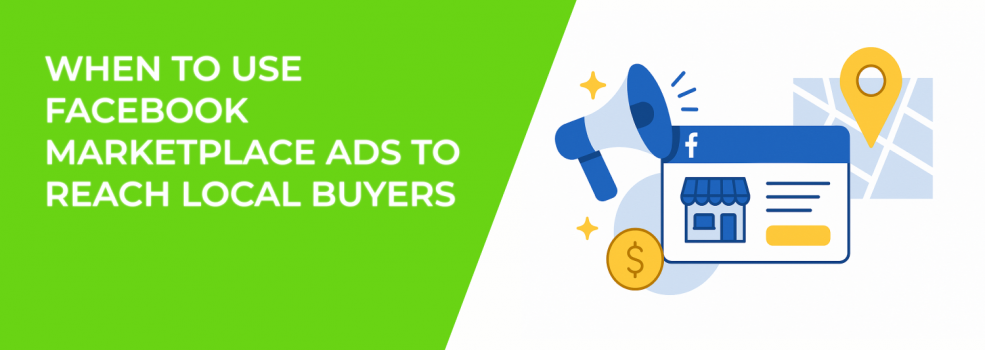If you’re trying to connect with customers in your area — not nationwide, not global — then Facebook Marketplace Ads might be one of the most underused, high-intent placements at your disposal.
They don’t look flashy. They’re not designed for storytelling. But they reach people who are already shopping, already searching, and most importantly — already in your neighborhood.
So when does it actually make sense to use them? Let’s break it down.
What Are Facebook Marketplace Ads?
Facebook Marketplace Ads appear in the Marketplace feed alongside local listings. Unlike other placements, they blend in with listings but offer full creative control, advanced targeting, and trackable performance.
You can use standard formats — single image, video, carousel, or collection — and pair them with traffic, conversions, or catalog sales objectives.
The power of Marketplace is context. People are browsing with buying intent. They’re not casually scrolling; they’re ready to act.
To build a full strategy around local visibility, explore the step-by-step Facebook marketing strategy for local businesses.
When Facebook Marketplace Ads Work Best
Marketplace ads work in specific situations. If your offer and audience match the environment, they can outperform other placements.
Here are the most effective use cases:
-
You’re targeting local buyers. Marketplace is built around location relevance. Local businesses — from florists to auto shops — can use it to reach people nearby.
-
You want fast results from intent-driven shoppers. Users come to Marketplace to browse products or services they’re ready to act on.
-
You offer pickup, appointments, or home services. Marketplace connects well with buyers looking for convenience and speed.
These scenarios often lead to higher engagement and lower cost per result compared to broader placements.
When Marketplace Ads Might Not Be Right
Not every brand or campaign type is a good fit for Marketplace. Some offers simply don’t align with the environment or user mindset.
Avoid Marketplace ads in the following cases:
-
Your offer is national or global. Marketplace’s appeal lies in proximity.
-
You’re promoting high-end or premium-positioned products. Marketplace users tend to be price-sensitive and comparison-driven.
-
Your funnel requires long nurturing or education. Users are in a buying mindset — not a learning phase.
If you see a warning like “Ad Set May Get Zero,” it may mean your audience is too small. Learn how to fix that in this detailed guide.
How to Set Up Facebook Marketplace Ads Properly
Marketplace ads are not created within the Marketplace itself — they’re built in Facebook Ads Manager, just like any other campaign. But they require a few setup steps specific to this placement.
Here’s what you need to do:
-
Choose a relevant campaign objective. For Marketplace, that usually means Traffic, Conversions, or Catalog Sales. If you're unsure, refer to this Meta campaign objectives guide.
-
Manually select Marketplace as a placement. You can use Automatic Placements, but it's worth checking manually to ensure Marketplace is included.
-
Target geographically. Use ZIP codes or city-based targeting for local accuracy.
-
Design for mobile-first. Square images (1:1) look clean and load fast.
-
Monitor placement performance separately. Always check how Marketplace is performing against Feed, Reels, or Stories placements.
A well-set-up ad increases your odds of showing up to the right person, at the right time.
Tips for Creating Marketplace Ads That Convert
Marketplace users are intentional. They’re not just browsing — they’re buying. Your ad needs to match that energy.
Start with your visuals. Marketplace is image-first.
-
Use clean, realistic photos. Skip branding overlays and stock images. Showcase the product or service in real-world context.
Then get specific with your text.
-
Mention price, urgency, and location. Include the cost, where the product or service is available, and why the user should act now. For example: “$129 — Pickup in Tampa — This Weekend Only.”
And remember the environment.
-
Avoid overly branded creative. Ads that blend into Marketplace — but still look professional — tend to perform best.
If you run an e-commerce catalog or local inventory feed, consider using Facebook’s Dynamic Ads. These can populate Marketplace automatically with high-intent product matches based on user behavior.
Learn more about optimizing audiences in this comprehensive guide.
Retargeting Marketplace Visitors
Not everyone will convert right away — but anyone who clicks has shown intent. Retargeting those users can bring strong results.
Here are some effective retargeting options:
-
Offer a time-sensitive discount. A second-chance offer can help nudge people over the line.
-
Use social proof. Show testimonials or reviews from customers in the same city.
-
Remind with inventory cues. Phrases like "Back in stock" or "Only a few left" can drive urgency.
If your ad is getting views but no results, something else may be wrong. Use this troubleshooting guide to check for funnel or targeting issues.
Final Thoughts
Facebook Marketplace Ads aren’t for everyone — but for local businesses trying to reach in-market buyers, they can deliver fast results with high intent.
When your offer is location-based, your timing is relevant, and your ad looks native to the environment, Marketplace ads can become one of your highest-ROI placements.
Want to see how Marketplace stacks up to other placements? Read this placement strategy breakdown to learn what drives performance across Facebook surfaces.

